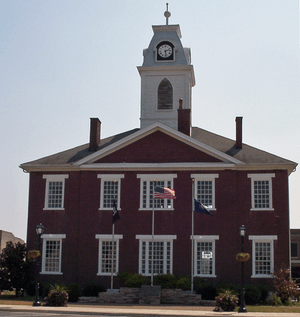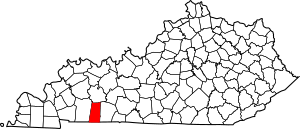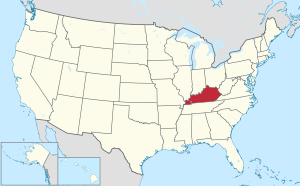Todd County, Kentucky facts for kids
Quick facts for kids
Todd County
|
|
|---|---|

Todd County Courthouse
|
|

Location within the U.S. state of Kentucky
|
|
 Kentucky's location within the U.S. |
|
| Country | |
| State | |
| Founded | 1820 |
| Named for | John Todd |
| Seat | Elkton |
| Largest city | Elkton |
| Area | |
| • Total | 377 sq mi (980 km2) |
| • Land | 374 sq mi (970 km2) |
| • Water | 2.6 sq mi (7 km2) 0.7% |
| Population
(2020)
|
|
| • Total | 12,243 |
| • Estimate
(2023)
|
12,494 |
| • Density | 32.47/sq mi (12.539/km2) |
| Time zone | UTC−6 (Central) |
| • Summer (DST) | UTC−5 (CDT) |
| Congressional district | 1st |
Todd County is a county in Kentucky, a state in the United States. In 2020, about 12,243 people lived there. The main town, or county seat, is Elkton. The county got its name from Colonel John Todd. He was a soldier who died in 1782 during the American Revolution.
Contents
History of Todd County
Early Beginnings
Todd County has two main natural areas. The northern part has hills and forests with trees like oak and poplar. The southern part has flat, rolling lands with rich soil. Long ago, the Cherokee people lived here. They were a Native American group who used the land for hunting.
This area was once part of Virginia. Many early European settlers came from Virginia. The land was given to soldiers who fought for Virginia in the American Revolutionary War.
Some of the first known settlers were Edward Shanklin Jr. and the Huston family. Samuel Davis, whose son Jefferson Davis later became famous, also settled here.
How Todd County Was Formed
People living in this area found it hard to travel to the main towns of Logan and Christian counties. They asked for their own local government. A group of important citizens, including Edward Shanklin, made this request.
So, on April 1, 1820, Kentucky officially created Todd County. It was made from parts of Christian and Logan counties. The new county was named after Colonel John Todd.
Developing the Area
Farming has always been very important in Todd County. The southern flatlands have excellent soil for growing crops.
In the early 1800s, Major John Gray started a stagecoach business. Stagecoaches were like buses pulled by horses. His main stop was in "Graysville," which is now Guthrie, Kentucky. Major Gray's business was very successful, and he became wealthy. He built a house called "Halcyon," also known as the John Gray House.
Major Gray wanted a town near his home to be the county seat. He designed the town, which he named "Elkton." He named it after the many elk that drank from a spring nearby. Gray designed the town square in a special way. He made sure the buildings would get lots of sunlight. He also helped pay for the first county courthouse.
The first courthouse was later replaced because it wasn't built well. A new courthouse was built in 1834. It was designed in a style called Federal Style. This building is still standing today. It has a tall clock tower that was added later.
The Civil War Years
During the American Civil War, Kentucky was a state with divided loyalties. Many people in Kentucky did not own enslaved people. But some wealthy landowners in areas like Todd County did. These owners had a lot to lose if slavery ended.
Kentucky officially tried to stay neutral at first. But in September 1861, it supported the Union. In response, some Kentuckians who supported the Confederacy formed their own government.
Geography of Todd County
Todd County covers about 377 square miles. Most of this area, about 374 square miles, is land. The rest is water.
Neighboring Counties
Todd County shares its borders with these other counties:
- Muhlenberg County (to the north)
- Logan County (to the east)
- Robertson County, Tennessee (to the southeast)
- Montgomery County, Tennessee (to the southwest)
- Christian County (to the west)
Population Information
| Historical population | |||
|---|---|---|---|
| Census | Pop. | %± | |
| 1830 | 8,680 | — | |
| 1840 | 9,991 | 15.1% | |
| 1850 | 12,268 | 22.8% | |
| 1860 | 11,575 | −5.6% | |
| 1870 | 12,612 | 9.0% | |
| 1880 | 15,994 | 26.8% | |
| 1890 | 16,814 | 5.1% | |
| 1900 | 17,371 | 3.3% | |
| 1910 | 16,488 | −5.1% | |
| 1920 | 15,694 | −4.8% | |
| 1930 | 13,520 | −13.9% | |
| 1940 | 14,234 | 5.3% | |
| 1950 | 12,890 | −9.4% | |
| 1960 | 11,364 | −11.8% | |
| 1970 | 10,823 | −4.8% | |
| 1980 | 11,874 | 9.7% | |
| 1990 | 10,940 | −7.9% | |
| 2000 | 11,971 | 9.4% | |
| 2010 | 12,460 | 4.1% | |
| 2020 | 12,243 | −1.7% | |
| 2023 (est.) | 12,494 | 0.3% | |
| U.S. Decennial Census 1790-1960 1900-1990 1990-2000 2010-2021 |
|||
In 2000, there were 11,971 people living in Todd County. There were 4,569 households, which are groups of people living together. The population density was about 32 people per square mile.
Most people in the county were White (89.32%). About 8.75% were Black or African American. A small number of people were from other racial groups. About 1.66% of the population identified as Hispanic or Latino.
About 33.50% of households had children under 18 living with them. The average household had about 2.59 people. The average family had about 3.05 people.
The population was spread out by age. About 26.60% were under 18 years old. About 14.00% were 65 years or older. The average age was 36 years.
Fun Places to Visit
Todd County has several interesting places to visit:
- Green River Female Academy
- Milliken Memorial Community House
- Old Oaks Farm
- Old Todd County Courthouse
- Jefferson Davis State Historic Site
- Robert Penn Warren Birthplace
- Glover's Cave
- Liberty Hall
- Edwards Hall
- John Gray House, "Halcyon"
- Northington
- Sunny Side Acres
- Pilot Rock
- Holly Hills
- Runnymede
- Guthrie Transportation Museum
Communities in Todd County
Cities
Census-Designated Places
These are areas that are like towns but not officially incorporated as cities:
- Allensville
- Fairview (mostly in Christian County)
Other Small Communities
- Allegre
- Claymour
- Clifty
- Daysville
- Hadensville
- Kirkmansville
- Pea Ridge
- Penicktown
- Pinchem
- Sharon Grove
- Tiny Town
- Tress Shop
- Tyewhoppety
Education
Todd County has one main school system called the Todd County School District.
Famous People from Todd County
Many notable people have come from Todd County:
- George Street Boone, a scholar who studied the Constitution.
- Francis Marion Bristow, a Congressman and lawyer.
- Benjamin Bristow, the first Solicitor General of the United States. He was also a U.S. Treasury Secretary.
- Mary Louise Milliken Childs, a person known for giving money to good causes.
- Jefferson Davis, who was the President of the Confederacy during the Civil War.
- Dorothy Dix (Elizabeth Merriwether Gilmer), a famous newspaper writer.
- Caroline Meriwether Goodlett, who helped start the United Daughters of the Confederacy.
- Caroline Gordon, an author who wrote many novels.
- Kent Greenfield, a professional baseball player.
- James Clark McReynolds, a former Justice on the United States Supreme Court.
- Roger Q. Mills, a former U.S. Senator from Texas.
- Paul Rudolph, a well-known architect.
- Edward Shanklin Sr., a soldier from the Revolutionary War and a founder of the county.
- James Gordon Shanklin, an FBI Agent.
- Jess Sweetser, the first American-born golfer to win the British Amateur tournament.
- David S. Terry, a judge and politician from California.
- Robert Penn Warren, the first person to be named the poet laureate of the United States.
See also
 In Spanish: Condado de Todd (Kentucky) para niños
In Spanish: Condado de Todd (Kentucky) para niños

